Securitas Bundle
How Did a Swedish Security Firm Become a Global Powerhouse?
Journey back in time to uncover the Securitas SWOT Analysis, a global leader in security services, and witness its remarkable transformation from a local Swedish security company to an international force. Discover how a simple vision, born in 1934, evolved into a comprehensive suite of security solutions, protecting assets and people worldwide. Explore the key milestones that shaped the Securitas story, from its founding to its current global presence.
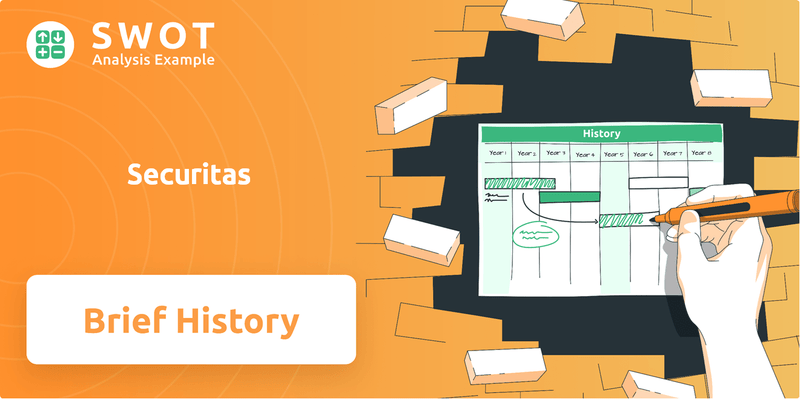
This article delves into the brief history of Securitas, examining its early years and strategic expansions within the security industry. We'll explore the company's evolution, from its initial guarding services to its integrated security solutions, and analyze the factors that propelled its growth. Understanding the Securitas company background provides valuable insights into its current market position and its ability to adapt to evolving client needs.
What is the Securitas Founding Story?
The Securitas story began on January 1, 1934, in Helsingborg, Sweden. Erik Philip-Sörensen, the founder, saw a need for more organized security services, moving beyond traditional night watchmen. His aim was to build a modern company offering reliable protection to businesses and individuals.
Philip-Sörensen, drawing on his experience in the security industry, created a company focused on professional guarding services. This included static guarding and mobile patrols to protect properties. The company's name, 'Securitas,' which means 'security' in Latin, perfectly captured its mission. The initial funding came from Philip-Sörensen himself, recognizing the growing demand for structured security during Sweden's industrialization in the 1930s.
This Securitas company background shows how a vision for professional security services took shape. It highlights the early days of a company that would become a global leader in the security industry.
Here are some key aspects of Securitas' founding:
- Founding Date: January 1, 1934.
- Founder: Erik Philip-Sörensen.
- Initial Focus: Guarding services for commercial and industrial properties.
- Name Origin: 'Securitas' is Latin for 'security.'
- Funding: Primarily from Erik Philip-Sörensen.
Securitas SWOT Analysis
- Complete SWOT Breakdown
- Fully Customizable
- Editable in Excel & Word
- Professional Formatting
- Investor-Ready Format
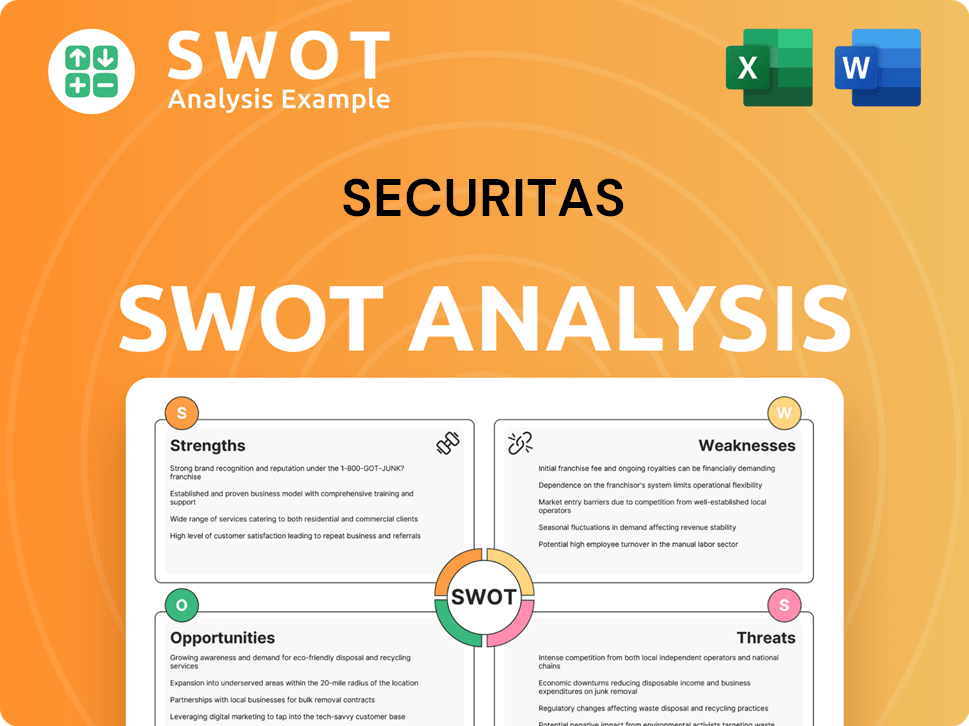
What Drove the Early Growth of Securitas?
The early growth of the Securitas company, a prominent player in the security industry, was characterized by strategic expansion within Sweden. This expansion involved broadening its security services and increasing its geographical reach. The company focused on building a strong client base by providing reliable guarding services and expanding its operational capabilities.
Initially, Securitas focused on refining and expanding its core services. These services included static guarding and mobile patrol services. The company tailored these offerings to meet the specific needs of various clients, ranging from small businesses to large industrial complexes. This approach allowed for a flexible and client-focused service model.
A key aspect of Securitas's early growth was its expansion across Sweden. This was often achieved through the acquisition of smaller security firms, which enabled rapid establishment of a national presence. By the 1940s, the company began to introduce advanced security technologies, such as alarm systems, to enhance its services.
The integration of alarm systems with guarding services marked an early diversification of product categories. Leadership transitions within the Philip-Sörensen family also played a crucial role in guiding the company's growth during this period. The market recognized the value of outsourced security services, contributing to the company's expansion.
The competitive landscape in Sweden was fragmented, which allowed Securitas to consolidate its position through strategic acquisitions and a focus on quality service. These early growth efforts established Securitas as a dominant force in the Swedish security company market. To understand the competitive environment, you can read about the Competitors Landscape of Securitas.
Securitas PESTLE Analysis
- Covers All 6 PESTLE Categories
- No Research Needed – Save Hours of Work
- Built by Experts, Trusted by Consultants
- Instant Download, Ready to Use
- 100% Editable, Fully Customizable
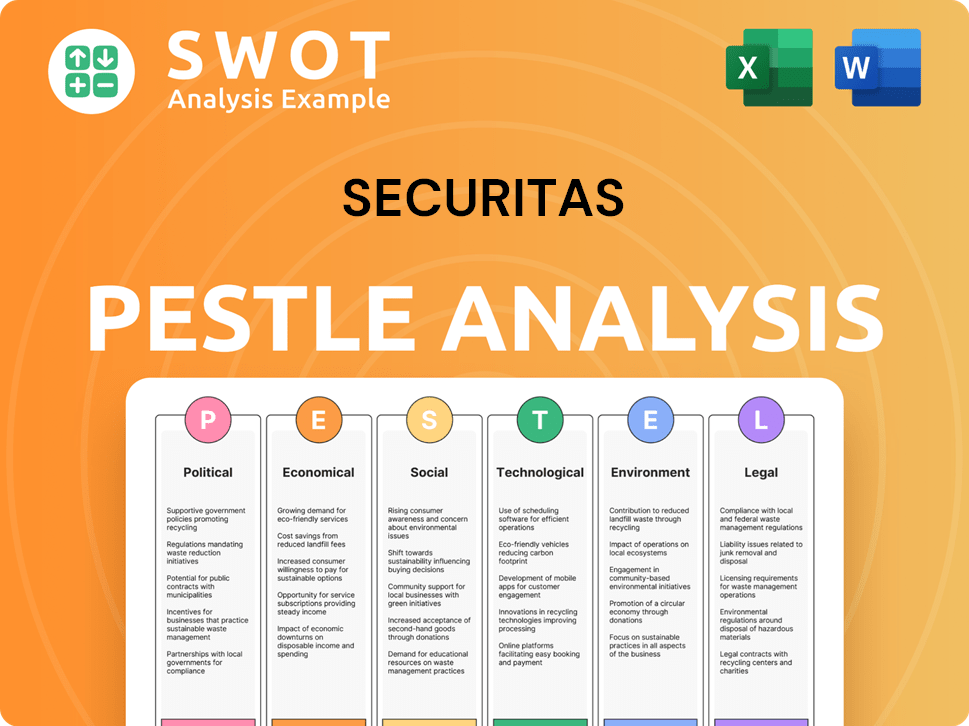
What are the key Milestones in Securitas history?
The Securitas history is marked by significant strategic moves and operational expansions, solidifying its position in the security industry. From its early beginnings, the Swedish security company has evolved through various stages of development, adapting to the changing demands of the market and embracing technological advancements.
| Year | Milestone |
|---|---|
| 1934 | Founded in Sweden, marking the beginning of Securitas's journey in the security services sector. |
| 1940s-1950s | Expansion within Sweden, establishing a foundation for future international growth and solidifying its presence in the local market. |
| 1970s-1980s | International expansion begins, with acquisitions and operations established in several European countries, extending its reach beyond Sweden. |
| 1990s | Further global expansion, including entry into North America and other key markets, transforming Securitas into a global player. |
| 2000s | Strategic acquisitions and restructuring to enhance its service offerings and market position, including the integration of technology-based security solutions. |
| 2010s-2020s | Focus on integrated security solutions, incorporating advanced technologies like AI and data analytics to enhance service efficiency and effectiveness. |
Securitas has consistently innovated in the security industry, particularly with its 'connected security' solutions. These solutions integrate advanced technology with traditional guarding services, offering clients more efficient and proactive security measures.
The integration of technology with guarding services to provide more efficient and proactive security, including remote video monitoring and access control.
Use of AI and analytics to predict and prevent incidents, enhancing the efficacy of security services and providing clients with actionable insights.
Incorporating advanced technologies like AI, robotics, and IoT devices to enhance security operations and provide clients with cutting-edge solutions.
Offering cybersecurity solutions to protect clients' digital assets, reflecting the growing importance of digital security in the modern landscape.
Developing mobile security solutions for enhanced site protection and real-time incident response. This includes patrol management and mobile surveillance.
Implementing smart security systems that integrate various components like sensors, alarms, and surveillance cameras to provide comprehensive protection.
Despite its advancements, Securitas has faced challenges, including economic downturns and competitive pressures. The transition to integrated security solutions also presented internal challenges, requiring significant investment in training and adapting its workforce.
Economic recessions impacting client budgets for security services, requiring strategic adjustments and cost-management measures to maintain profitability.
Competition from both traditional guarding companies and new technology-focused security providers, necessitating continuous innovation and differentiation to maintain market share.
The transition from physical guarding to integrated security solutions required significant investment in retraining and adapting the workforce to new technologies and service models.
The increasing sophistication of cybersecurity threats in the 2020s has necessitated significant investment in cybersecurity measures and training to protect client data and systems.
Changes in security regulations and compliance requirements across different regions, requiring continuous adaptation and adherence to maintain operational integrity and client trust.
Integrating new technologies and systems into existing infrastructure, which can be complex and require significant investment in both hardware and software, as well as staff training.
Securitas Business Model Canvas
- Complete 9-Block Business Model Canvas
- Effortlessly Communicate Your Business Strategy
- Investor-Ready BMC Format
- 100% Editable and Customizable
- Clear and Structured Layout
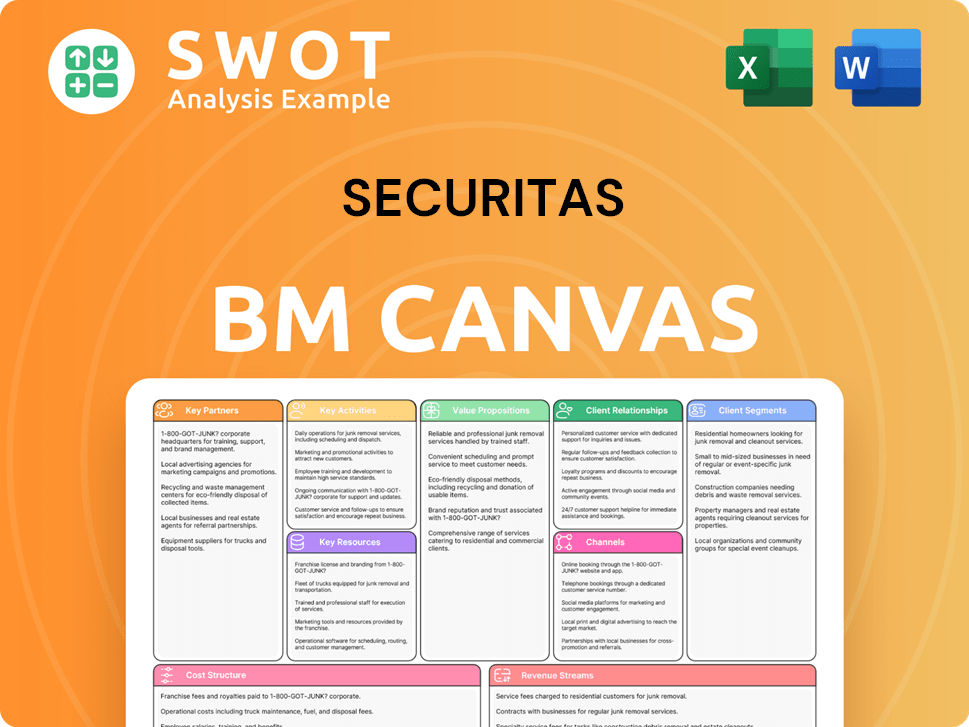
What is the Timeline of Key Events for Securitas?
The Securitas company's journey began in 1934 in Helsingborg, Sweden, and has since evolved into a global leader in security services. The Securitas history is marked by strategic expansions, technological integrations, and a consistent focus on providing reliable security solutions worldwide. From its early days as a Swedish security company to its current status, Securitas has adapted to meet the changing demands of the security industry.
| Year | Key Event |
|---|---|
| 1934 | Founded as AB Securitas in Helsingborg, Sweden, marking the beginning of the company's journey. |
| 1940s-1960s | Expanded across Sweden and diversified into alarm systems, broadening its service offerings. |
| 1970s | Began its international expansion, starting with other Nordic countries, extending its reach beyond Sweden. |
| 1980s | Experienced significant international growth, including expansion into the US market, solidifying its global presence. |
| 1991 | Listed on the Stockholm Stock Exchange, providing access to capital for further growth and development. |
| 2000s | Continued global expansion through acquisitions, focusing on the integration of security technology to enhance its services. |
| 2006 | Divested the alarm installation business (Niscayah) to concentrate on core security services, streamlining its operations. |
| 2010s | Emphasized 'connected security' and data-driven solutions, adapting to the evolving needs of the security landscape. |
| 2020 | Acquired Stanley Security, a strategic move to strengthen its technology-enabled security solutions, expanding its portfolio. |
| 2024 | Operates in 44 markets, with approximately 341,000 employees globally; 2023 net sales reached SEK 153,939 million. |
Securitas is currently focused on its 'Securitas Strategy 2025,' which is centered on technology and solutions for profitable growth. This strategy aims to improve client value by integrating technology into its services and expanding its presence in higher-value security solutions. The company is also leveraging data analytics to enhance its service offerings and client outcomes.
The security industry is seeing increasing sophistication in cyber threats and a rising demand for integrated and proactive security measures. These trends are likely to influence Securitas's future direction, pushing the company towards more technology-enabled services. Analyst predictions support this shift, aligning with Securitas's strategic initiatives.
Leadership emphasizes Securitas's commitment to innovation and delivering tailored security solutions to meet client needs. The company's approach combines its founding vision with advanced technology and a global reach, ensuring it remains at the forefront of the security services sector. This commitment underscores its ability to adapt and provide comprehensive solutions.
Securitas anticipates continued growth in electronic security and security solutions segments. The company's strategic initiatives, including the integration of technology and expansion of high-value services, are designed to support its long-term growth objectives. The company's strong financial performance and strategic acquisitions, as discussed in an article about Securitas, position it well for future success.
Securitas Porter's Five Forces Analysis
- Covers All 5 Competitive Forces in Detail
- Structured for Consultants, Students, and Founders
- 100% Editable in Microsoft Word & Excel
- Instant Digital Download – Use Immediately
- Compatible with Mac & PC – Fully Unlocked
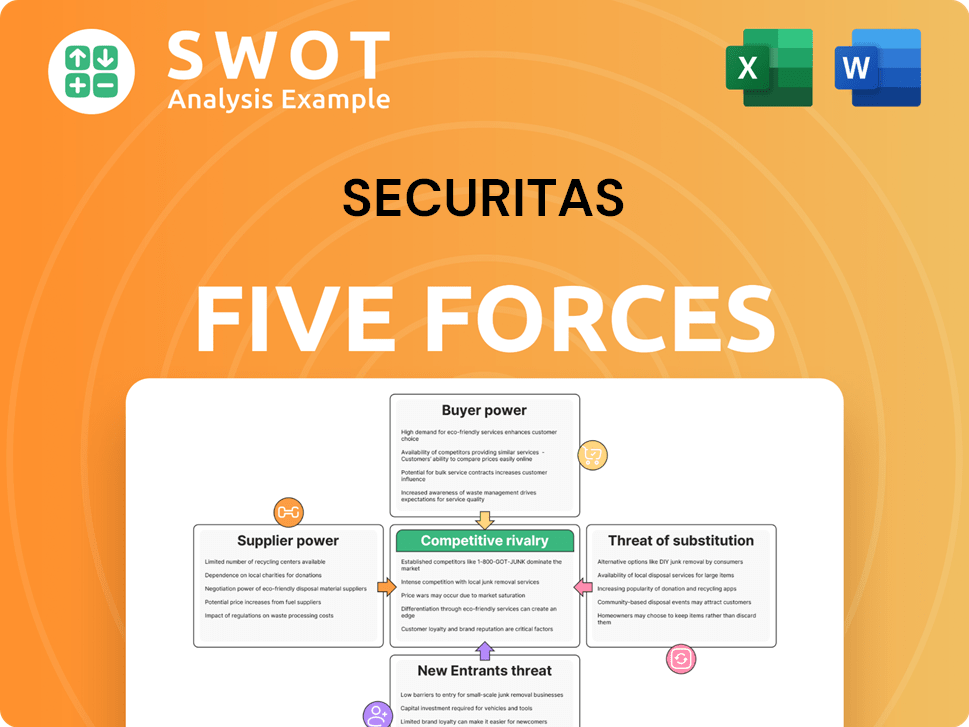
Related Blogs
- What is Competitive Landscape of Securitas Company?
- What is Growth Strategy and Future Prospects of Securitas Company?
- How Does Securitas Company Work?
- What is Sales and Marketing Strategy of Securitas Company?
- What is Brief History of Securitas Company?
- Who Owns Securitas Company?
- What is Customer Demographics and Target Market of Securitas Company?
Disclaimer
All information, articles, and product details provided on this website are for general informational and educational purposes only. We do not claim any ownership over, nor do we intend to infringe upon, any trademarks, copyrights, logos, brand names, or other intellectual property mentioned or depicted on this site. Such intellectual property remains the property of its respective owners, and any references here are made solely for identification or informational purposes, without implying any affiliation, endorsement, or partnership.
We make no representations or warranties, express or implied, regarding the accuracy, completeness, or suitability of any content or products presented. Nothing on this website should be construed as legal, tax, investment, financial, medical, or other professional advice. In addition, no part of this site—including articles or product references—constitutes a solicitation, recommendation, endorsement, advertisement, or offer to buy or sell any securities, franchises, or other financial instruments, particularly in jurisdictions where such activity would be unlawful.
All content is of a general nature and may not address the specific circumstances of any individual or entity. It is not a substitute for professional advice or services. Any actions you take based on the information provided here are strictly at your own risk. You accept full responsibility for any decisions or outcomes arising from your use of this website and agree to release us from any liability in connection with your use of, or reliance upon, the content or products found herein.